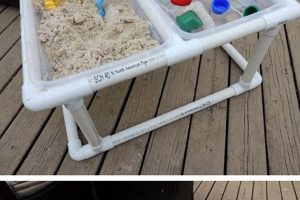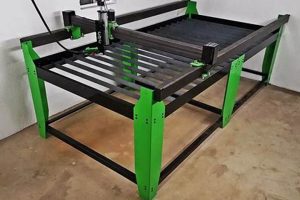The construction of tables utilizing repurposed wooden shipping platforms represents a specific form of do-it-yourself woodworking. This activity typically involves disassembling, modifying, and reassembling the wooden structure to create a functional furniture piece. For instance, a standard shipping platform might be sanded, stained, and fitted with legs to produce a coffee table.
Engaging in such projects presents several advantages. It promotes sustainable practices by diverting waste from landfills. Furthermore, it provides an affordable alternative to purchasing manufactured furniture. Historically, the utilization of reclaimed materials for furniture construction reflects a tradition of resourcefulness, particularly evident during periods of economic constraint.
The subsequent sections will detail specific techniques for material selection, preparation, and construction, outlining best practices for creating durable and aesthetically pleasing furniture from reclaimed shipping platforms. The focus will be on safety, efficiency, and achieving professional-quality results.
Essential Considerations for Pallet Table Construction
The following recommendations provide guidance for individuals undertaking the process of creating tables from repurposed shipping platforms. Adherence to these guidelines can enhance the quality, safety, and longevity of the finished product.
Tip 1: Material Sourcing. Prioritize heat-treated pallets marked with the “HT” stamp. These have undergone a sterilization process suitable for indoor use, mitigating the risk of pest infestation and chemical contamination.
Tip 2: Structural Integrity Assessment. Thoroughly inspect each platform for signs of damage, including cracks, rot, and loose fasteners. Compromised materials should be rejected to ensure the table’s stability and prevent potential hazards.
Tip 3: Disassembly Technique. Employ appropriate tools, such as a reciprocating saw or specialized pallet dismantling tools, to minimize wood splitting and maximize material yield during deconstruction.
Tip 4: Surface Preparation. Rigorous sanding is essential to eliminate splinters, smooth rough edges, and prepare the wood for staining or sealing. Begin with a coarse grit sandpaper and progress to finer grits for optimal results.
Tip 5: Joint Reinforcement. Utilize wood glue and screws or nails to reinforce joints, ensuring structural integrity and preventing movement over time. Consider employing metal brackets for additional support at critical connection points.
Tip 6: Protective Finishing. Apply a sealant or varnish to protect the wood from moisture, stains, and scratches. Select a finish appropriate for the intended use of the table, prioritizing durability and resistance to wear and tear.
Tip 7: Hardware Selection. Choose high-quality fasteners, hinges, and other hardware components that are resistant to corrosion and capable of withstanding the weight and stress associated with table use.
By carefully considering these factors throughout the construction process, individuals can create functional and aesthetically pleasing tables from reclaimed shipping platforms while minimizing potential risks and maximizing the lifespan of the finished product.
The subsequent sections will address advanced techniques for surface treatment and customization, enabling further refinement of the finished furniture piece.
1. Pallet Selection
Pallet selection constitutes a foundational element in the do-it-yourself pallet table construction process. The characteristics of the chosen platform directly influence the structural integrity, aesthetic qualities, and potential safety hazards of the completed furniture piece. For example, selecting a pallet constructed from hardwood, such as oak, will generally yield a more durable and stable table compared to a pallet made from softwood like pine. Conversely, a platform previously used to transport hazardous materials poses a contamination risk, rendering it unsuitable for indoor furniture use.
The identification of appropriate pallets requires a comprehensive understanding of pallet markings and treatment methods. Pallets marked with “HT” indicate heat treatment, a process used to sterilize the wood without the use of harmful chemicals, making them a safer choice. Pallets labeled with “MB,” however, have been treated with methyl bromide, a toxic fumigant, and are strongly discouraged. Furthermore, the visual inspection of each pallet for signs of damage, such as cracks, rot, or insect infestation, is crucial to ensure the material’s suitability. A table constructed from compromised materials will exhibit reduced load-bearing capacity and an increased risk of failure.
Therefore, a deliberate and informed approach to pallet selection is paramount. Prioritizing heat-treated pallets from reputable sources, coupled with a rigorous inspection for structural defects, mitigates potential health risks and contributes to the creation of a stable and aesthetically pleasing finished product. Neglecting these considerations can compromise the project’s safety and longevity, highlighting the integral relationship between material selection and the successful execution of do-it-yourself pallet table construction.
2. Disassembly Method
The chosen method for disassembling shipping platforms significantly influences the efficiency, material yield, and safety of pallet table construction. Selecting an appropriate technique is crucial for preserving the integrity of the wood and minimizing potential hazards.
- Tool Selection and its Impact
The type of tools employed directly affects the condition of the reclaimed wood. Using a reciprocating saw with a metal-cutting blade, while efficient, can result in wood splintering and increased material waste. Conversely, specialized pallet dismantling tools, such as pry bars or pneumatic nail pullers, are designed to separate the wood components with minimal damage. The choice of tool dictates the degree of post-disassembly processing required.
- Nail and Fastener Removal Techniques
The method of nail and fastener removal impacts both wood integrity and worker safety. Forceful prying without proper support can lead to wood cracking and splintering. Techniques that involve leverage and controlled force, such as using a nail puller in conjunction with a wooden block for support, reduce the risk of damage. Furthermore, the use of safety glasses and gloves is essential to prevent injury from flying debris and sharp fasteners.
- Minimizing Material Waste
Efficient disassembly techniques contribute to a higher yield of usable lumber. Careful planning and execution, including strategical cuts and lever placement, minimize the likelihood of splitting or breaking the wood. This reduces the need for replacement materials and promotes a more sustainable construction process. Disassembly should be approached with the goal of preserving as much usable material as possible.
- Safety Considerations and Best Practices
Safe disassembly practices are paramount. The use of personal protective equipment, including eye protection, gloves, and sturdy footwear, is mandatory. Maintaining a clear and organized workspace reduces the risk of trips and falls. Furthermore, the proper handling and disposal of removed fasteners prevents potential injuries and environmental hazards. Adhering to established safety protocols is crucial for a successful and injury-free disassembly process.
The implementation of a well-considered disassembly method is not merely a preparatory step but an integral component of successful pallet table construction. The techniques employed during this phase directly influence the quality, quantity, and safety of the resulting project, underscoring the importance of careful planning and execution.
3. Surface Treatment
Surface treatment represents a critical stage in the successful execution of pallet table construction. The process directly influences the aesthetic appeal, tactile quality, and long-term durability of the finished furniture piece. Untreated wood surfaces obtained from repurposed shipping platforms often exhibit roughness, splinters, and embedded contaminants, rendering them unsuitable for direct use in furniture applications. Proper surface preparation mitigates these deficiencies, creating a smooth, safe, and visually appealing surface.
The selection of appropriate surface treatment techniques depends on the desired aesthetic and the intended use of the table. Sanding, filling, staining, and sealing are common procedures. Sanding removes surface imperfections and creates a uniform texture, while wood fillers address larger voids and cracks. Staining enhances the wood’s natural grain or imparts a desired color, while sealing provides a protective barrier against moisture, stains, and wear. For example, a coffee table subjected to frequent spills requires a durable, water-resistant sealant to prevent damage to the underlying wood. Conversely, a purely decorative table might benefit from a more nuanced staining process to accentuate its aesthetic qualities.
In conclusion, surface treatment is not merely a cosmetic consideration but a fundamental aspect of pallet table construction that impacts both its functional performance and aesthetic value. The careful selection and application of appropriate techniques ensure a safe, durable, and visually pleasing finished product. Challenges in this area often involve selecting appropriate products compatible with the type of wood and the intended use of the table. Overcoming these challenges necessitates a thorough understanding of wood finishing principles and careful product selection.
4. Joint Strength
Joint strength constitutes a critical factor in the structural integrity and longevity of any table, including those constructed from repurposed shipping platforms. In the context of do-it-yourself pallet table construction, the strength of the joints directly correlates with the table’s load-bearing capacity, stability, and resistance to wear and tear.
- Fastener Selection and its Influence
The type of fasteners employed significantly impacts joint strength. Nails, screws, and bolts each offer varying degrees of holding power. Screws, particularly those designed for wood, generally provide superior holding strength compared to nails due to their threaded design, which allows them to grip the wood fibers more effectively. Bolt connections, when properly implemented with washers and nuts, offer the highest level of strength, making them suitable for high-stress joints. Inadequate fastener selection can result in joint failure under load.
- Adhesive Application and Bonding
The use of wood adhesives enhances joint strength by creating a continuous bond between the wood surfaces. Wood glue fills gaps and irregularities, distributing stress more evenly across the joint. Different types of wood glue offer varying levels of strength and water resistance. For outdoor tables or tables exposed to moisture, a water-resistant glue is essential to prevent joint failure due to water damage. Proper clamping during the adhesive curing process is critical to ensure a strong and durable bond.
- Joinery Techniques and Structural Integrity
The choice of joinery technique directly influences the overall strength of the connection. Simple butt joints, where two pieces of wood are joined end-to-end, are inherently weak and require significant reinforcement. More advanced joinery techniques, such as mortise and tenon joints, dovetail joints, and lap joints, offer increased surface area for bonding and mechanical interlocking, resulting in stronger and more durable connections. The selection of an appropriate joinery technique is crucial for ensuring the long-term stability of the pallet table.
- Reinforcement Methods for Enhanced Stability
Supplementary reinforcement methods can further augment joint strength, particularly in areas subjected to high stress. Metal brackets, corner braces, and gussets provide additional support and prevent joint movement. These reinforcements are particularly useful for legs and table aprons, where they can significantly improve stability and prevent wobbling. The strategic placement of reinforcement elements contributes to the overall robustness of the pallet table.
The effective integration of appropriate fasteners, adhesives, joinery techniques, and reinforcement methods is paramount for achieving adequate joint strength in do-it-yourself pallet table construction. Neglecting these considerations can lead to premature joint failure, compromising the table’s functionality and safety. The selection and implementation of these factors must align with the intended use and anticipated load of the finished product.
5. Leg Attachment
The secure and stable attachment of legs to a repurposed shipping platform is fundamental to the usability and safety of a do-it-yourself table. Inadequate leg attachment compromises the table’s stability, rendering it unsuitable for its intended purpose and potentially hazardous. The method employed must account for the weight of the table, anticipated load, and the characteristics of the shipping platform’s wood.
- Hardware Selection and its Influence
The selection of appropriate hardware, such as screws, bolts, or metal brackets, directly affects the strength and durability of the leg attachment. Screws must be of sufficient length and gauge to penetrate deeply into the wood of both the platform and the leg, ensuring a secure hold. Bolts, used in conjunction with washers and nuts, provide a stronger connection, particularly when attaching legs made of a different material, such as metal. Pre-drilling pilot holes is essential to prevent wood splitting, which can weaken the joint. Inappropriate hardware can lead to leg instability and eventual failure.
- Attachment Point Reinforcement
The areas where the legs attach to the shipping platform often require reinforcement to distribute the load and prevent damage to the relatively thin wood. Metal plates or wooden blocks can be used to reinforce the attachment points, providing a larger surface area for the legs to bear weight. This is particularly important for tables intended to support heavy objects. Neglecting reinforcement can result in localized stress and eventual cracking or breaking of the platform at the attachment points.
- Angle and Stability Considerations
The angle at which the legs are attached affects the table’s stability and overall aesthetic. Straight legs provide a simple and straightforward design but may not be suitable for larger tables or tables intended to bear heavy loads. Angled legs, splayed outward, increase the table’s footprint and improve its stability, particularly against tipping. Careful consideration must be given to the angle of the legs to ensure both aesthetic appeal and functional stability.
- Leg Material Compatibility
The choice of leg material should be compatible with the existing shipping platform wood. Attaching metal legs to a softwood platform requires careful consideration to prevent crushing or deformation of the wood. The use of a buffer material, such as a wooden plate or a rubber pad, can help to distribute the load and prevent damage. Similarly, attaching wooden legs to a metal platform requires a strong and secure connection method, such as welding or bolting, to ensure stability.
The successful attachment of legs to a do-it-yourself pallet table involves a combination of appropriate hardware, reinforcement techniques, and careful attention to angle and material compatibility. Failure to address these factors can result in an unstable and unsafe piece of furniture, highlighting the critical importance of meticulous planning and execution.
6. Protective Finish
The application of a protective finish is integral to the longevity and usability of tables constructed from repurposed shipping platforms. The porous nature of wood, especially when sourced from recycled materials, renders it susceptible to moisture absorption, staining, and physical damage. A properly selected and applied protective finish mitigates these vulnerabilities, extending the lifespan of the furniture piece and preserving its aesthetic qualities. For instance, an interior table exposed to beverage spills necessitates a water-resistant finish to prevent staining and warping. Similarly, a table intended for outdoor use requires a finish containing UV inhibitors to prevent fading and cracking due to prolonged sun exposure.
The choice of finish varies depending on the intended use and desired aesthetic of the table. Polyurethane offers a durable, water-resistant coating suitable for high-traffic surfaces. Varnish provides a traditional, glossy finish with good resistance to scratches and chemicals. Oil-based finishes penetrate the wood, enhancing its natural grain and providing a low-sheen, durable surface. The selection process should consider factors such as the type of wood, the intended environment, and the desired level of protection. Improperly applied finishes can result in blistering, cracking, or peeling, compromising both the appearance and protective qualities of the coating.
In summary, the implementation of a protective finish is not merely an aesthetic consideration but a functional necessity in the creation of tables from repurposed shipping platforms. The choice of finish, application technique, and ongoing maintenance directly impact the table’s durability, resistance to environmental factors, and overall longevity. Understanding the properties of different finishes and their suitability for specific applications is crucial for achieving a successful and durable end product. Neglecting this aspect can lead to premature degradation of the furniture piece, negating the benefits of the do-it-yourself construction process.
Frequently Asked Questions Regarding Pallet Table Construction
The following questions address common concerns and misconceptions associated with the construction of tables utilizing repurposed shipping platforms. The responses aim to provide clarity and guidance based on established practices and material properties.
Question 1: Are all shipping platforms suitable for furniture construction?
No, not all shipping platforms are appropriate for use in furniture construction. Platforms marked with “MB” indicate treatment with methyl bromide, a toxic fumigant, and should be avoided. Platforms previously used to transport hazardous materials may also pose a risk. Heat-treated (“HT”) platforms are generally considered safer for indoor use, but a thorough inspection for damage and contamination remains essential.
Question 2: Is sanding a necessary step in pallet table construction?
Yes, sanding is a critical step. Unprocessed shipping platforms typically exhibit rough surfaces, splinters, and potential contaminants. Sanding removes these imperfections, creating a smoother, safer, and more aesthetically pleasing surface suitable for finishing. The sanding process should progress through multiple grits, from coarse to fine, for optimal results.
Question 3: What type of sealant is most appropriate for a pallet table used outdoors?
For outdoor use, a sealant containing UV inhibitors is recommended. This will protect the wood from fading, cracking, and warping due to prolonged exposure to sunlight. Marine-grade varnishes and spar urethanes are specifically formulated for outdoor applications and provide excellent water resistance.
Question 4: How can joint strength be maximized when constructing a pallet table?
Joint strength can be maximized through a combination of appropriate joinery techniques, high-quality fasteners, and adhesive application. Dovetail joints, mortise and tenon joints, and lap joints offer superior strength compared to simple butt joints. Screws provide greater holding power than nails. Wood glue should be applied liberally to all joint surfaces, and the assembly should be clamped securely during the curing process.
Question 5: Is it necessary to reinforce the leg attachment points on a pallet table?
Reinforcement of the leg attachment points is often recommended, particularly for tables intended to support heavy loads. Metal brackets or wooden blocks can be used to distribute the weight and prevent localized stress on the platform’s wood. This is especially important when attaching legs made of a different material, such as metal, which can exert concentrated pressure on the softer wood of the shipping platform.
Question 6: What safety precautions should be taken when disassembling a shipping platform?
Safety precautions are paramount during platform disassembly. Eye protection, gloves, and sturdy footwear should be worn at all times. A clear and organized workspace minimizes the risk of trips and falls. Proper tools, such as pry bars or specialized pallet dismantling tools, should be used to minimize wood splitting and material waste. Removed fasteners should be disposed of safely to prevent injuries.
These responses highlight key considerations for safe and effective pallet table construction. Adherence to these guidelines can improve the quality, safety, and longevity of the finished product.
The following section will present case studies showcasing successful pallet table designs and construction techniques.
Pallet Table DIY
This exploration of pallet table DIY has underscored the crucial elements necessary for successful execution. Material selection, disassembly methods, surface treatment, joint strength, leg attachment, and protective finishing all play critical roles in determining the final product’s structural integrity, aesthetic quality, and overall longevity. The careful consideration and implementation of each stage are essential for mitigating potential risks and maximizing the utility of repurposed materials.
The information presented serves as a foundation for informed decision-making in the pursuit of sustainable and cost-effective furniture creation. Continued adherence to best practices and a commitment to safety will ensure that pallet table DIY remains a viable and responsible approach to resource utilization.







